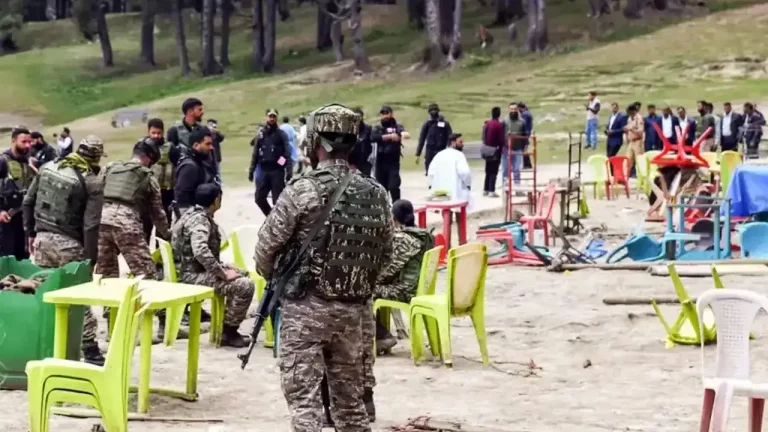One month ago, on April 22, the nation was shaken to its core by the ghastly terror attack in Jammu and Kashmir’s Pahalgam, which claimed 26 innocent lives, most of them Hindu tourists enjoying the scenic beauty of the valley.
It was one of the deadliest assaults in the region in recent years. But since that dark day, much has changed in India’s counter-terrorism strategy. From military operations and diplomatic offensives to heightened civil preparedness, the nation’s response has reflected a renewed sense of resolve, strategy, and national unity.
India’s robust shifting diplomacy
India’s diplomatic engine roared to life before the military retaliation. Just a day after the Pahalgam terror attack, the Indian government suspended the Indus Waters Treaty — a decades-old water-sharing agreement with Pakistan. It not only sent a strong signal of strategic disengagement but also shook Pakistan’s ecosystem mounting pressure for accountability.
India also shut down the Attari-Wagah border, halting trade and people-to-people movement and suspending visas for Pakistani nationals with immediate effect. Expelled Pakistani diplomats, including military attachés, and gave all Pakistani nationals in India a 48-hour deadline to leave.
India revoked all previously issued visas to Pakistani nationals and imposed a comprehensive travel ban under the SAARC Visa Exemption Scheme. This measure was intended to prevent potential threats and to convey India’s zero-tolerance policy towards terrorism.
Boots on the Ground, message in the sky: Operation Sindoor
India’s immediate yet well-thought retaliation to the Pahalgam bloodshed was Operation Sindoor, a wide-ranging, precise and targeted military offensive launched to dismantle the terror networks behind the terrorist attacks in India and abroad.
Under Operation Sindoor, the Indian armed forces targeted nine key terror camps deep in Pakistan and Pakistan-occupied Kashmir and managed to neutralise more than 100 terrorists.
Security forces also zeroed in on militants operating across South Kashmir, particularly in Anantnag and Pulwama. In one of the most high-profile missions since the Pulwama attack, caches of weapons, encrypted devices, and propaganda material were seized.
Security upgrades and civil preparedness
Unlike the previous terror attacks in the last decade, the Pahalgam terror attack was communal, targeted civilians and more importantly it was personal for the Modi government.
Due to the brutality and nature of the assault, the focus shifted beyond the borders and turned inward. Authorities gave the military full operational freedom to decide the scope, timing, and targets of any future strike.
India also clarified that any further act of terrorism against India sponsored by Pakistan will be considered an ‘act of war’, not only a pertinent warning for the nation that harbours terrorists but also a message to the world that India will no longer sit back.
Meanwhile, the nationwide civil defence drill ‘Operation Abhyaas’ was also conducted on May 7 across 244 districts. From blackout simulations and evacuation exercises to public awareness campaigns, the drill prepared citizens for emergency scenarios — an unusual but telling move.
Tourism did take a hit
The Pahalgam tragedy sparked a conversation about national security and intelligence failure, a lapse that cannot be sidelined or avoided. However, it also casts a long shadow over Kashmir’s economy, which depends on tourism.
As news of the attack spread, tourists left the valley in droves, hotels emptied, and hundreds of houseboats along Dal Lake lay abandoned.
“At this time of the year, we should have been full of tourists, a booming economy, children should have been at school, airports should have been functioning with 50-60 flights a day. “But now, the Valley is empty, schools have to be closed, and the airport and airspace are closed,” Jammu and Kashmir chief minister Omar Abdullah said in one of these interviews.
Though, the best part about India is its capability to change, mostly for the better. Gradually, the situation in the valley is improving.
Regarding the conflict, India agreed to a ceasefire understanding following a call from Pakistan’s Director General of Military Operations (DGMO) to Indian officials, proposing a halt to hostilities. The agreement was formally announced on May 10.
Officials now estimate that it may take six months or more for tourism to recover, depending on how stable the region remains.
The narrative war and global outreach
The Indian government announced a anti-terror global outreach programme after Operation Sindoor, which notably is still ongoing. Under this, the Modi government will send seven all-party delegations to more than 30 countries.
The aim is to put across India’s resolve to tackle terrorism against the backdrop of Operation Sindoor.
What changed and what’s next?
One month has passed, and some questions are still unanswered but the message from India is clear: Any act of terror against India or Indians will not go unanswered – diplomatically, militarily, or economically. The combination of swift retaliation, global outreach, and internal readiness shows a new picture of a more assertive India, unwilling to play defence anymore.
While tensions with Pakistan remain high and will continue to do so until the neighbour takes the responsibility it has been ducking for decades, there’s still a strategic restraint shown, despite public outrage. This reflects a maturing doctrine: calculated escalation, not emotional reaction.
While the memory of the painful Pahalgam attack would never linger in the hearts of Indians, the nation has started to heal, with its guards up and eyes wide open, borders sealed tight, and a counter-strike always one step away.

